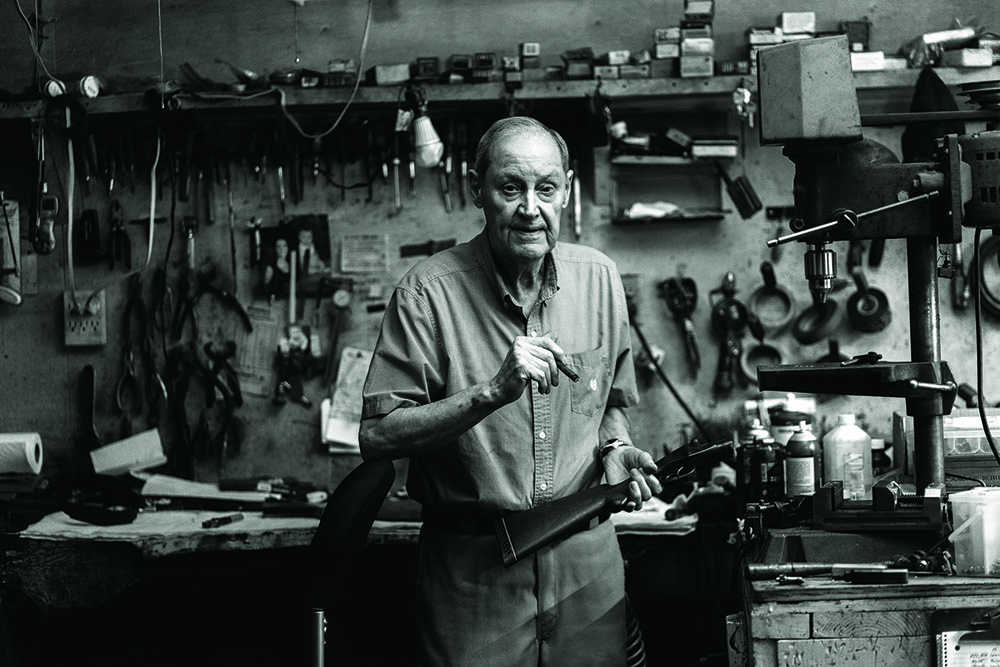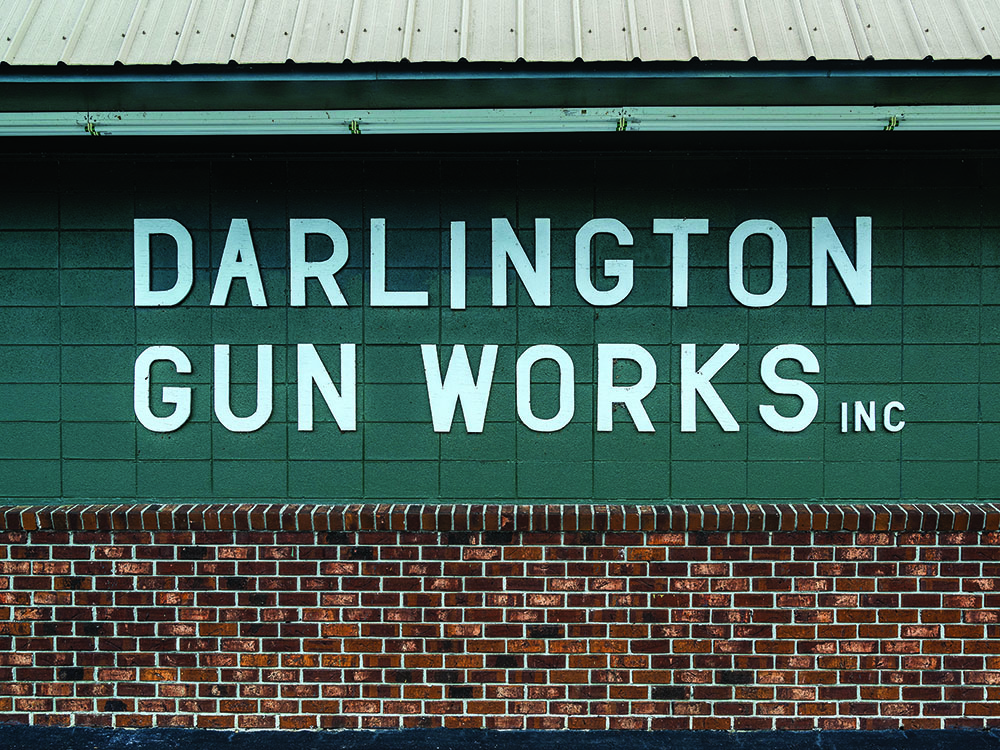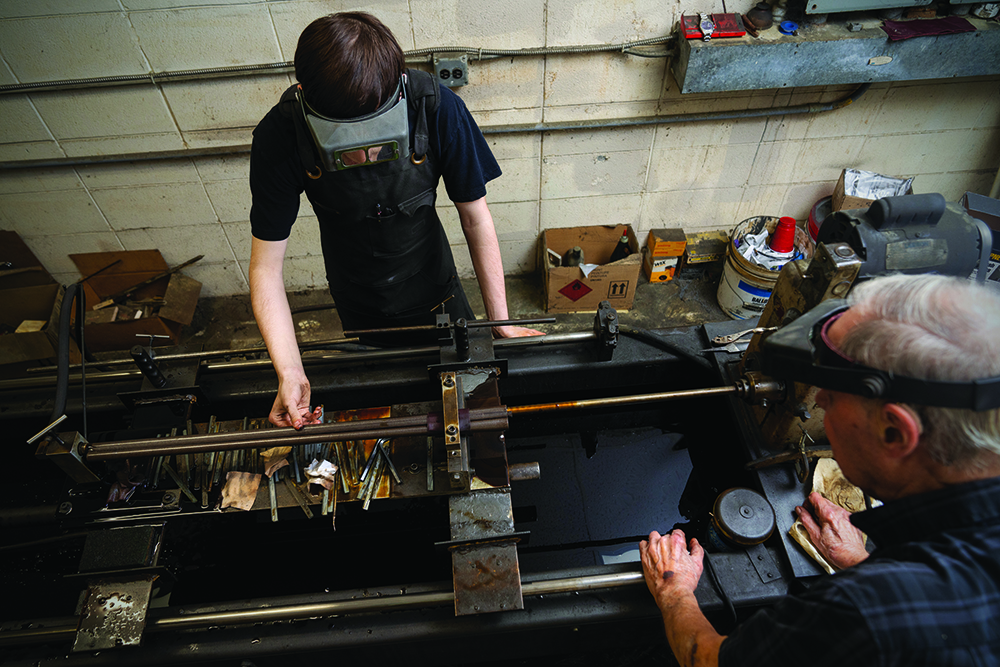A Rare Jim

Large white letters against a green brick façade spelled out “Darlington Gun Works” and confirmed the location of Jim Kelly and his shop. Otherwise, it hid in plain sight among the industrial buildings that dotted the four-lane highway on the outskirts of downtown Darlington, South Carolina. Inside the small storefront, historical posters, family photos, and vintage guns hung from the wood-paneled walls. Closer inspection revealed makes and models by Westley Richards, E.J. Churchill, A.H. Fox, and Parker Brothers. Two large carousels in the center of the room held several field-grade models by L.C. Smith, Lefever, and Ithaca. On one wall, a sign stating, Your wife called. She said: Buy anything you want, adorned one wall among the memories, memorabilia, and firearms. I chuckled a bit and a polite voice from a petite woman behind the counter said, “I hung that so people wouldn’t have to ask permission.” Jim’s wife, Diane Kelly, introduced herself and led me behind the counter to meet her husband.
Around the corner, four gunsmiths were focused on their projects beneath bright fluorescent light without any music or small talk breaking the silence—just the gentle tapping of tools and the rasp of sandpaper against wood were audible. Large pieces of heavy machinery suggested the work was loud at times, but for now their projects required a gentle hand. Diane led me to a workstation veiled in a thin cloud of cigar smoke. “This is my husband, Jim Kelly,” she said. When Jim raised his head after a few final strokes of sandpaper to a gun stock, part of me regretted disturbing his progress. “It’s a pleasure to meet you,” he enthusiastically replied, setting at ease any angst I felt from bothering him.
We quietly left the others to their work as Jim led me on a tour of the shop. While explaining the purpose of each station, he shared detailed stories about his vintage machinery. His buffing machine for finishing blued metal came from Winslow Arms—a now defunct boutique riflemaker from Camden, South Carolina—that built a custom rifle for President Lyndon B. Johnson. His circa-1940s barrel-honing machine came from a Remington Arms factory where it helped produce weapons during World War II. Outside of the glass-beading station, a beautiful set of barrels in-the-white for a 10-gauge L.C. Smith awaited the next step on their restorative pilgrimage. Beneath the corrosion that once blemished their surfaces, these barrels looked as fresh as the day they were forged. “Ninety percent of the repairs we do are from abuse. It’s difficult to wear out a quality gun from shooting if you’re using proper ammunition and cleaning it regularly,” he said.

At the bluing station, which Jim called the “Hell Room,” blackened brick walls hinted at the intense heat generated in this small corner space of his operation. Though they did a lot of hot bluing, he explained why there was no substitute for rust bluing an older double gun. “If you hot blue barrels on a double gun, they’ll separate from the rib within six months or less while you’re shooting it. But a lot of gunsmiths keep doin’ it because it’s faster.” Jim shook his head before pulling a drag from his cigar and said, “They ought to know better, but I guess you don’t know what you don’t know.” He pardoned their ignorance and acknowledged that his level of expertise was born from a childhood passion that hasn’t waned in 72 years.
Jim made simple black powder and cartridge guns from spare parts by the time he was 12 years old. Though his father didn’t hunt, he encouraged Jim’s enthusiasm and arranged an apprenticeship of sorts with a shoe repairman whom Jim called a “gun tinkerer” because the cobbler had no formal training. “If one of the hammers on your hammer gun broke, he’d solder it back together. If your stock busted, he’d fuse it with bailing wire and leather,” Jim recalled. At age 14, he earned enough money from his paper route to buy a Stevens 311 from Western Auto for $52. He paid $2.50 a week until his father remitted the last $5 on his behalf just in time for Christmas. He found the gun years later after it had endured years of abuse from his brothers, and when he showed it to me, the shiny stock and fresh bluing offered no visual evidence that the Stevens ever saw the field. “Nothin’ special about ‘em, but they function,” he said as he returned the pristine Stevens into its sock. Since it still held a spot in his impressive collection, it seemed apparent that its value couldn’t be monetized.
During his junior year of high school in 1953, Jim saw an advertisement by the United States Air Force for gunsmiths and ran to the local recruiting station. But the recruiter hadn’t heard of the program, and he encouraged Jim to finish high school before coming back. The ink on his diploma was barely dry before he reappeared at the recruiting station. It wasn’t until after he finished armament school that he learned only two candidates would be selected for the gunsmith program. Undeterred by the odds, Jim earned one of the slots and departed for his station in Dreux-Louvilliers, France, as a “small arms gunsmith specialist.”

He toured the gun shops of the Loire River Valley and developed an insatiable interest in their work with double guns. His enthusiasm endeared him to some local gunsmiths, and for the next three years, Jim immersed himself in their culture and tradition of gunsmithing. Instead of replacing factory-made parts on a gun, he learned to create them by hand from raw metal. He studied their techniques for choosing the best wood blanks of figured walnut, sculpting them into gun stocks, and hand-tooling the checkering into their grips and fore-ends. “In the United States, a fella gets to thinking, I wanna be a gunsmith. Then he takes some classes, and he’s a gunsmith. That’s not so in France. I learned most of what I know about double guns over there. And I’ve built just about every part on a gun at one time or other,” he explained.
After his time in the service, Jim returned home and earned an undergraduate degree in accounting. He worked in banking for 38 years but fueled his passion for firearms by selling and servicing guns as a side hustle. He partnered with a friend and fellow veteran named Buck Henry Sellars in 1969, and they opened Southern Gun Works across the street from NASCAR’s Darlington Raceway. After splitting the business in 1977, Jim built Darlington Gun Works on the same ground and in the same building it occupies today.
We continued our tour through the stockroom where beautiful blanks of Circassian walnut filled a section of floor-to-ceiling shelves on the back wall. He selected a few blanks from the stack and rubbed them with a rag to reveal their marbled figuring. Each one looked as individual and unique as a fingerprint, and several pieces from the stack held more value than the total cost of many modern firearms. As the price of fine wood climbs higher, Jim said he regrets not buying more walnut and sending it home while he was in France. He chose the most beautiful blank from the shelf and said, “I could’ve bought wood like that in France for $10 while I was there.” We lamented his missed opportunity at a lucrative investment and continued to the case-hardening room. A boxlock action for an Ithaca waited next to a furnace where it would be heated to 1,500 degrees before being quenched in a tank of dark brown water. An air hose agitated the water to produce bubbles and stir up the bits of charcoal, bone, and leather providing its tint and texture. After that Ithaca action is quenched, a beautiful layer of colored carbon will coat it in marbled greens and blues. “We only change the water once a year now. I used to do it after every quench, but the older and dirtier the water, the richer the color. You wouldn’t believe it, but it’s true,” Jim said.

Around midday we returned to the work benches where the other gunsmiths had lifted their heads for a well-deserved break. After making their acquaintance, I asked Jim about the time Nash Buckingham’s “Bo Whoop” shotgun walked into his shop for a stock repair. Nash wrote books about the sporting life during the early 20th Century and referenced the gun several times in his works, naming it Bo Whoop for the sound of its report after being fired. Jim recalled that he suspected this particular “Super Fox”—an A.H. Fox in 12-bore with 3-inch chambers choked full and full—was indeed Bo Whoop, but consulted his library to confirm the serial numbers. Jim played it close to the vest and asked the stranger who delivered the gun if he’d be willing to sell it. “I knew within minutes what that gun was, and I offered him $20,000 on the spot,” Jim recalled. “He stepped back and said, ‘I guess you would!’ He knew what he had then.” Jim repaired the gun, and after it sold at auction for a little over $200,000, it was donated to Ducks Unlimited and resides at their headquarters in Memphis, Tennessee. Jim went on to say of all the American double guns made in the early 20th Century, he considered A.H. Fox to be the best of them. “The triggers and ejectors on a Fox are perfect, and that’s the Achilles heel of a Parker.”
Jim showed me his most daunting restoration jobs and called them “basket cases” because many of them arrived in a basket as a rusted pile of parts and a set of barrels. Such was the condition of a 20-gauge Parker CH with ejectors and 24-inch barrels. When it was brought to his shop in 2003, he researched the gun and discovered it was one-of-a-kind, so he bought it and made a stunning restoration from the wreckage. The Parker he showed me wore a pistol gripped stock of fine walnut and featured a cheek rest and fine checkering. It looked like a brand-new gun, and it was hard to imagine it was once a “basket case.” He told me it was one of his finest achievements as a master gunsmith.
At least a dozen customers darkened the door of Darlington Gun Works while I visited, and my gracious hosts couldn’t afford to prop their feet too long. Before returning to his work, Jim relit his cigar and said that he never thought much about not being around until he turned 70. “I got scared for a little while that I wouldn’t find anyone to replace me. I’m 84 years old now, and my assistant gunsmith, Ward Buffkin, is 86.” But he also professed a strong faith in the power of double guns, believing their rich history and accumulated character will always be en vogue to the right people at the right time. Jim’s son-in-law and head gunsmith, Josh Stanley, was his first apprentice, and his 19-year-old nephew, Taylor Watford, now apprentices under Jim.
The dedication of these young men confirmed his stated belief that, “There’ll always be some kid out there like me who’ll love these guns…and they’ll have to fix ‘em because it’s a passion.” When the temptation of an antique double gun proves too strong and a purchase is made, the latest custodian in its lineage should offer a prayer of thanks for those elite few like Jim who keep them running.
Originally published in Volume 9, Number 1 (Dec-Jan 2021) of Covey Rise.
























